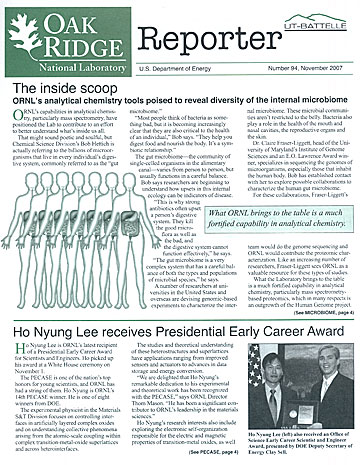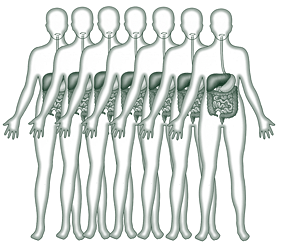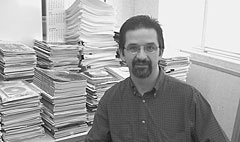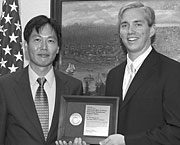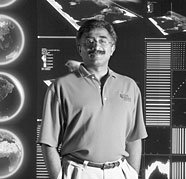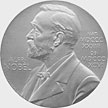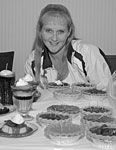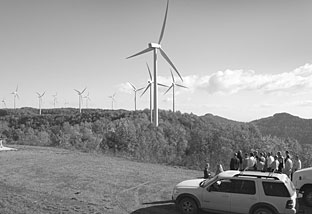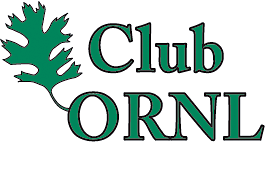 |
Number 94, November 2007 |
 The inside scoop
The inside scoop
ORNL’s analytical chemistry tools poised to reveal diversity of the internal microbiome
|
|
ORNL’s capabilities in analytical chemistry, particularly mass spectrometry, have positioned the Lab to contribute to an effort to better understand what’s inside us all.
That might sound poetic and soulful, but Chemical Science Division’s Bob Hettich is actually referring to the billions of microorganisms that live in every individual’s digestive system, commonly referred to as the “gut microbiome.”
“Most people think of bacteria as something bad, but it is becoming increasingly clear that they are also critical to the health of an individual,” Bob says. “They help you digest food and nourish the body. It’s a symbiotic relationship.”
The gut microbiome—the community of single-celled organisms in the alimentary canal—varies from person to person, but usually functions in a careful balance. Bob says researchers are beginning to understand how upsets in this internal ecology can be indicators of disease.
“This is why strong antibiotics often upset a person’s digestive system. They kill the good microflora as well as the bad, and the digestive system cannot function effectively,” he says.
What ORNL brings to the table is a much fortified capability in analytical chemistry. |
|---|
“The gut microbiome is a very complex system that has a careful balance of both the types and populations of microbial species,” he says.
A number of researchers at universities in the United States and overseas are devising genomic-based experiments to characterize the internal microbiome. These microbial communities aren’t restricted to the belly. Bacteria also play a role in the health of the mouth and nasal cavities, the reproductive organs and the skin.
Dr. Claire Fraser-Liggett, head of the University of Maryland’s Institute of Genome Sciences and an E.O. Lawrence Award winner, specializes in sequencing the genomes of microorganisms, especially those that inhabit the human body. Bob has established contact with her to explore possible collaborations to characterize the human gut microbiome.
For these collaborations, Fraser-Liggett’s team would do the genome sequencing and ORNL would contribute the proteomic characterization. Like an increasing number of researchers, Fraser-Liggett sees ORNL as a valuable resource for these types of studies.
What the Laboratory brings to the table is a much fortified capability in analytical chemistry, particularly mass spectrometry-based proteomics, which in many respects is an outgrowth of the Human Genome project. This global research project was instrumental in pushing the envelope of high-throughput DNA sequencing, which is the building block for mass spec-based proteome measurements. Mass spec is used to ferret out the protein signature information that is critical to understanding the molecular machinery of life.
|
|
Bob Hettich has a personal stake in learning more about the human-health aspects of internal microbial balance. |
The project that helped alert the research community to ORNL’s capabilities had little to do with human health. In 2005, Bob and fellow ORNL staff member Nathan VerBerkmoes, working with Jillian Banfield at the University of California at Berkeley, characterized the complex proteome of a colony of extremophile microbes living in the drainage of a defunct California gold mine. Despite the incredibly hostile soup, the microorganisms were thriving, which Bob describes as akin to living in sulfuric acid.
DOE’s interest in such critters mainly lies in learning how environmental microbes cooperate and compete in natural communities, thereby pooling their collective resources to reduce toxic materials and aid in environmental cleanup. Health researchers, on the other hand, note the similarity to microbial community life inside the gut.
Another leader in studying the human microbiome, Washington University’s Jeff Gordon, is investigating the possible role the gut microbiome may play in obesity by studying identical twins.
Gordon is expert at creating abiotic mice, in which the microbiome may be obliterated or manipulated for comparative studies. For example, Gordon has demonstrated how to generate control mice whose gut microflora have been virtually eliminated. Subsequent inoculation of these “sterile-gut” mice with microflora from either lean or obese mice provides a systematic way to study how the gut microflora influence obesity.
We can explore these complex relationships because we now have the tools. |
|---|
More complex studies could identify the human genetic traits of abnormalities or diseases and explore the effects genetics might have on the microbiome from individual to individual. For example, inflammatory bowel diseases such as ulcerative colitis and Crohn’s disease are thought to be strongly influenced by a complex interplay between human genetic factors and gut microbiome characteristics.
Bob is hoping to partner with Gordon on a National Institutes of Health roadmap project to map out the normal human microbiome. He has visited Gordon’s lab in St. Louis and has viewed the complex metrics that Gordon’s studies require.
“What we can offer to Jeff is the ability to look at the proteome signatures of the microflora,” Bob says. “Although this is anticipated to be a very complex problem, we have the analytical chemistry expertise and mass spectrometry technology to begin these studies. We want to collaborate with the people who know how to control and manipulate the microflora to probe particular biological
questions.”
The human-health aspects of this internal microbial balance, of which not a lot is known in view of its complexity, are enormous. The subject is of particular personal interest to Bob, whose daughter suffers from Crohn’s disease, a chronic inflammation of the digestive system that can make life miserable for the afflicted.
What is learned from these studies could pave the way for new treatments for Crohn’s and similar digestive system maladies.
“We’re at a time in science that we can explore these complex relationships because we now have the tools. The unprecedented availability of complete genome sequences for both single microbes as well as microbial communities, which wasn’t even thought possible 10 years ago, has revolutionized our understanding of the tremendous complexity and impact of the microbial world on our human existence.” Bob says.
“Mass spectrometry is one of the critical technologies that can provide a starting point for these types of studies.”—B.C. ![]()
 Ho Nyung Lee receives Presidential Early Career Award
Ho Nyung Lee receives Presidential Early Career Award
|
|
Ho Nyung Lee (left) also received an Office of Science Early Career Scientist and Engineer Award, presented by DOE Deputy Secretary of Energy Clay Sell. |
Ho Nyung Lee is ORNL’s latest recipient
of a Presidential Early Career Award for Scientists and Engineers. Ho picked up his award at a White House ceremony on November 1.
The PECASE is one of the nation’s top honors for young scientists, and ORNL has had a string of them. Ho Nyung is ORNL’s 14th PECASE winner. He is one of eight winners from DOE.
The experimental physicist in the Materials S&T Division focuses on controlling interfaces in artificially layered complex oxides and on understanding collective phenomena arising from the atomic-scale coupling within complex transition-metal-oxide superlattices and across heterointerfaces.
The studies and theoretical understanding of these heterostructures and superlattices have applications ranging from improved sensors and actuators to advances in data storage and energy conversion.
“We are delighted that Ho Nyung’s remarkable dedication to his experimental and theoretical work has been recognized with the PECASE,” says ORNL Director Thom Mason. “He has been a significant contributor to ORNL’s leadership in the materials sciences.”
Ho Nyung’s research interests also include exploring the electronic self-organization responsible for the electric and magnetic properties of transition-metal oxides, as well as investigating the fundamental aspects of ferroelectrics. These atom-scale phenomena are key to the development of advanced materials for a broad range of uses.
He is credited with advancing the versatile, layer-by-layer method of high-pressure, pulsed-laser deposition for growing complex-oxide heterostructures previously thought to be achievable only by molecular beam epitaxy.
He received his doctorate in physics from Korea University in 1999 and joined ORNL as a strategic hire in 2002 following a postdoctoral appointment at Germany’s Max Planck Institute of Microstructure Physics. Ho Nyung has published more than 50 peer-reviewed papers that have been cited over 600 times, including publications in the top scientific journals.
Ho Nyung has presented more than 30 invited talks, seminars or university colloquia. In 2002 he received the first Bombi Prize of the Korean Physical Society for outstanding research in condensed matter physics by a young scientist under the age of 35. He also won UT-Battelle’s 2005 Science and Technology Award for best scientific research by a team or individual.
Ho Nyung lives in Oak Ridge with his wife, Hyun-Suk, and two children, Jimin and Andrew.
John Marburger, director of the White House Office of Science and Technology Policy, presented the award. —B.C. ![]()
 C&CS chief Thomas Zacharia adds a post at UT
C&CS chief Thomas Zacharia adds a post at UT
|
|
Computing & Computational Sciences ALD Thomas Zacharia will also hold a top post at the University of Tennessee. |
Associate Laboratory Director for Computing and Computational Sciences Thomas Zacharia has taken on an additional position at the University of Tennessee. He has been named UT vice president for science and technology.
Thomas will continue to lead the CCS directorate at ORNL. At UT, he is a professor in the Department of Electrical Engineering and Computer Science.
UT President John Petersen says the joint appointment marks a new level of participation and integration for the UT-ORNL partnership that enhances the capabilities of both institutions. UT Executive Vice President David Millhorn emphasizes computing’s growing role in research as a driver in Thomas’s selection.
“At the University of Tennessee, Dr. Zacharia will coordinate efforts to integrate supercomputing into our research programs at the university’s various campuses across the state,” Millhorn says. “Supercomputing is an increasingly important tool used to solve complex problems as complex and diverse as those being studied in the fields of healthcare, engineering and climate change. Having Dr. Zacharia join UT’s senior leadership will strengthen the university’s goal of becoming a leader in high-performance computing.”
Petersen said the joint appointment marks a new level of participation and integration for the UT-Oak Ridge partnership that enhances the capabilities of both institutions by sharing the expertise of key individuals.
“Dr. Zacharia’s appointment as UT vice president for science and technology also provides a unique opportunity for maximizing the extraordinary assets generated through this partnership,” Petersen says.
Lab Director Thom Mason says Thomas’s new role “is a significant milestone, both for UT-Battelle’s management of the Laboratory and for the growing research partnership between ORNL and UT.”
Thomas recently led UT and ORNL in establishing a partnership with the National Science Foundation and led the joint proposal for a $65 million award to build one of the world’s most powerful supercomputers at the Joint Institute for Computational Sciences. In August, the NSF notified the UT-ORNL team of approval for the grant that, if finalized, would further strengthen the UT-ORNL partnership among the ranks of the nation’s elite centers of high-performance computing.
The award would represent the largest research grant in the university’s history. ![]()
 Herb Mook, Peter Cummings elected AAAS fellows
Herb Mook, Peter Cummings elected AAAS fellows
|
|
Mook |
Two ORNL researchers have been elected fellows of the American Association for the Advancement of Science by the AAAS Council.
Senior researcher Herb Mook was cited for his “pioneering experiments using neutron scattering in materials that test theories leading to understanding of novel physics and new directions of research.”
Herb started his neutron science career at ORNL in 1965; his experiments have employed neutron beams from the now decommissioned Oak Ridge Research Reactor and the more powerful High Flux Isotope Reactor, which was recently upgraded with new beam lines and a cold neutron source.
|
|
Cummings |
Fifty of his papers have been cited more than 50 times, with more than 8,000 citations overall. His co-authors include the late Nobel laureate Clifford Shull. He holds three patents and has two R&D 100 awards.
Vanderbilt professor Peter Cummings, who directs the NanoScience Center’s Nanomaterials Theory Institute, was cited for his “outstanding contributions in research, for extraordinary service to his profession, and for national leadership in the emerging field of theoretical and computational nanoscience.”
Peter, who is also the John R. Hall Professor of Chemical Engineering at Vanderbilt, has authored more than 270 refereed journal papers and is a frequently invited speaker at international meetings throughout the world.
Herb and Peter will be recognized as new fellows at the AAAS annual meeting in
February. ![]()
 Anderson leads NScD
Anderson leads NScD
|
|
Anderson |
Ian Anderson has been named associate
Laboratory director for the Neutron Sciences Directorate, a job he has had on an interim basis since July 1.
Ian joined the Spallation Neutron Source project in March 2002 as director of the Experimental Facilities Division and became director of the Neutron Scattering Science Division when the Neutron Sciences Directorate was formed.
Before coming to ORNL Ian led the Neutron Optics Laboratory at the Institut Laue-Langevin in Grenoble, France. He has more than 25 years of experience in carrying out active research programs in the field of hydrogen in metals and developed neutron scattering techniques in major research facilities both in Europe and the United States.
Ian obtained his doctorate and master’s in physics from Birmingham University and B.A. and M.A degrees in natural sciences from the Univ.ersity of Cambridge, England. ![]()
 |
 Piece of the Peace Prize
Piece of the Peace Prize
At last April’s Earth Day celebration, Tom Wilbanks recalled how ORNL research in the 1970s helped spark the passing of important and lasting environmental laws; an example, he said, of how science can make a
difference.
That point of view gained considerable support last month when the Nobel Peace Prize was shared by former Vice President Al Gore and the United Nations’ Intergovernmental Panel on Climate Change. Several ORNL researchers—Tom, David Greene, Paul Hanson, Virginia Dale and Gregg Marland—have contributed to publications incorporated by the IPCC.
|
|
The Lab’s Center for Computational Sciences also contributed, with the Cheetah system crunching more than one-third of the simulation data for the joint DOE-National Science Foundation contribution to the IPCC’s Fourth Assessment Report. That effort was led by the CCS’s John Drake.
IPPC Chairman Rajendra K. Pachauri of India was quick to note what it all meant: “This makes all of you a Nobel laureate,” he said in a congratulatory letter to participants.
Like the climate change process itself, research goes on. Tom Wilbanks, who was coordinating lead author on an IPCC report on impacts, adaptation and vulnerabilities, rolled out a U.S. Climate Change Science Program report the very next week on climate change impacts on energy production and use, an area that has previously received relatively little study.
 Southeast can catch up on EE
Southeast can catch up on EE
Kateri Callahan, president of the Alliance to Save Energy, says the United States is seeing an unprecedented movement toward energy efficiency, which she describes as “the nation’s greatest natural resource.” The non-profit ASE was founded 30 years ago as a coalition that represents business, government, environmental and consumer groups.
While bioenergy, nuclear and other expanding energy options get much of the press, “the potential of energy efficiency is probably greater than any other resource,” Callahan said at the October 23 seminar, hosted by ORNL’s Energy Efficiency & Renewable Energy program. The market is ripe for change, she said, thanks to a “perfect storm” of price hikes in oil, gas and other sources such as natural gas and propane, the gap between domestic energy production and consumption and environmental issues that link releases from fossil fuels to greenhouse emissions.
There is plenty of room for progress. Southern states spend only one-fifth the national average, per capita, on energy efficiency programs and rank near the bottom among regions in Energy Star appliance penetration.
To help bridge the gap, the ASE has helped create the Southeast Energy Efficiency Alliance, a diverse group of utilities, state energy offices, federal agencies, financial companies, environmental and energy efficiency organizations, public utility commissions and others including ORNL. ORNL EERE Director Bob Hawsey serves as an ex-officio member of the board.
 Syrup finding sticks to physicists
Syrup finding sticks to physicists
Almost as soon as the atom was first split in the late 1930s scientists were devising experiments to describe the events leading up to nuclear fission. The consensus was that the nucleus oscillates rapidly, like a drop of water, before breaking apart.
A new experiment, led by James S. Forster of Canada’s University of Montreal and Jens Ulrik Andersen of Denmark’s University of Aarhus has stirred the physics community in describing the lead-up to fission as a slower, much more gooey oscillation—more like a syrup. The potentially groundbreaking measurements were performed at ORNL’s
Holifield Radioactive Ion Beam Facility and are published in Physical Review Letters.
Forster and his team came to the Holifield Facility to take advantage of its high-quality ion beams and expertise: ORNL’s teams in atomic and nuclear physics have experience in several specialized techniques.
The experiment used a technique called blocking, in which a nucleus’s emissions from its position in a solid target are detected and measured after passing through the rows of atoms in a perfect tungsten crystal.
In the experiment, the tungsten target was bombarded with high-energy stable-ion beams. The target and beam nuclei briefly fuse to form an unstable compound nucleus before splitting, and fission emissions are blocked from exiting the crystal at certain angles by the tungsten crystal atomic strings. The detector identifies the fission fragments and records the directions they traveled through the crystal. The researchers used various ion beams and energies from the Holifield’s broad capabilities to explore compound nucleus lifetime effects.
ORNL’s atomic physics group is one of the few remaining with the expertise and specialized equipment to implement channeling and blocking techniques necessary to do this kind of experiment. The nuclear physics team also provided the nuclear physics expertise necessary to interpret the measurements.
“We knew we had the unique capabilities in beam quality and energy that would make the experiment likely to succeed,” says the Physics Division’s Jim Beene.
The ORNL team included Randy Vane and Herb Krause in atomic physics and ORNL nuclear physicists Jim Beene, Alfredo Galindo-Uribarri, Jorge Gomez del Campo, Elizabeth Padilla-Rodal and David Radford.
—Reported by Bill Cabage and Larisa Brass |
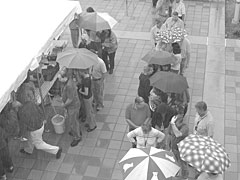 |
|
October 18’s Club ORNL Fall Festival was billed as rain or shine. We got both. Inside, the brief shower had no effect on the crafts displays, including the tasty-looking candles by Pam Halcomb. |
|
 ORNL People
ORNL People
The Materials S&T Division’s Amit Goyal has received the Pride of India Gold award. Sponsored by the NRI Institute, the award recognizes people of Indian origin for outstanding achievements in their chosen fields and public service contributions toward the economic development of India and the recipient’s country of residence. Amit was one of just 24 people selected for the award.
The American Society for Training & Development has recognized ORNL as one of its 2007 BEST Awards Program winners. The Lab’s entry highlighted the launch of the Developing Leadership Potential Program and the implementation of ORNL’s three-year Employee Engagement survey process. ORNL’s Training Management program ranked 16th among 42 international organizations. Training Manager Allen White facilitated a session at the ASTD’s professional development event October 3 in Washington.
 0.0000001
0.0000001
Metrology Lab’s accreditation is a world’s first, on a very fine line
 |
| The metrology Laboratory’s Leonard Presley has a rock-steady hand when it comes to calibrating lab weights and measures. |
The ORNL Metrology Laboratory’s Brian Sizemore says he pulled a hair out of his head one day and weighed it. The scale read 210 micrograms.
Keep that figure in mind.
The Metrology Lab recently received accreditation from the National Voluntary Laboratory Accreditation Program in the areas of mass, mass balance, relative humidity and laboratory thermometers. The lab is now accredited to calibrate mass sets and is the world’s first such facility that can provide NVLAP-accredited calibrations of analytical balances—of which ORNL has around 350—in the field.
The NVLAP accreditation means that data collected on ORNL’s Metrology Lab-calibrated instruments—including mass sets, balances (or commonly referred to as scales)—are traceable to the National Institute of Standards and Technology standards. And because the accreditation is traceable to SI units, the data also meet international standards, which is critical in a global research environment.
“The accreditation came after a heavyweight NVLAP assessment,” Brian says, with no pun intended. “It was an extremely rigorous evaluation.”
Because the Metrology Lab went through NVLAP’s accreditation paces, researchers across the Lab can be assured that their instruments are reading correctly.
“We can tell our customers what something weighs to one-tenth of a microgram,” says Brian, who is task leader in the lab, located in Building 2547. “That’s 0.0000001 grams.”
The stainless steel weight sets used by researchers come in sizes from tiny to just small, all packed into a little kit. They are so precise that the slightest environmental change can affect their readings, including dust, temperature, magnetism, air pressure or, for that matter, air.
“A cubic centimeter of air actually weighs 1.2 milligrams at standard conditions. We have to account for air buoyancy,” Brian says. “By calculating air density, we can account for it.”
The Crafts Resources Division’s Leonard Presley, a machinist by trade, is the lab’s master calibrator. His daily regime is to carefully check the accuracy of weights from one milligram—which is a little triangle of fine wire about as large as this W—to 50-pound dumbbells.
Technical manager Bill Wright praises Leonard’s rock-steady hands and concern for customers. He also gives Leonard high marks for buying into the NVLAP accreditation program.
“Leonard has mastered the art of taking good measurements. He changed his whole way of doing things,” Bill says.
So how does Leonard handle a weight that weighs only one-thousandth of a gram?
“Very carefully,” Leonard dryly responds.
Building 2547, located next to the central campus “green door” machine shop, is the last place you would expect to find one of the world’s state-of-the-art calibration labs. The lab is nestled in a building within a building, with careful climate control, kitchen-cleanliness and flypaper door mats to remove dust from shoes. With the planned central campus clean-up, the lab will likely move to new quarters in the coming years.
The NVLAP auditors’ initial skepticism—huge milling machines are located just outside—was overcome once they saw the improvements made to the facility. For example, they said an overhead manipulator that Leonard uses to hoist the heavier weights was one of the best such systems they had seen.
The lab aced the audit, with no deficiencies or opportunities for improvement cited.
“Nobody thought we were that good,” Bill says. “We’re good enough to calibrate mass sets that are good enough to calibrate analytical instruments, with reduced uncertainty.”
Metrology Lab group leader Mike Duncan says the Lab’s drive to become a world-class research facility led to their campaign to become world class in calibrating the instruments they use, including scales and weights.
“Our researchers can now have a high level of confidence and integrity in the measurements they make. This is one of the top 10 mass labs in the country,” Mike says.
The lab’s researchers depend on precision, and the Metrology Lab now provides it.
“Write your name on a piece of paper and we can tell you what the ink weighs,” Bill says.
Which brings us back to Brian Sizemore’s strand of hair, which weighed in at a comparatively robust 210 micrograms.
“We can split hairs,” he says.
That’s an understatement. This lab can split air.—B.C. ![]()
Solar summit: Day in the sun for regional solar energy tech
Visitors to ORNL’s October 24-25 Southeast Solar Summit, which showcased solar R&D and market opportunities in the region, saw a 5-kilowatt solar panel (above) installed on ORNL’s east campus and TVA’s wind turbines on Buffalo Mountain.
 Significant Event Awards mark outstanding efforts
Significant Event Awards mark outstanding efforts
Significant Event Awards were distributed recently to staff members for their outstanding accomplishments in research and operations. Congratulations to all.
Integrated Field Challenge at the Oak Ridge Field Research Center: Phil Jardine, David Watson, Craig Brandt, Baohua Gu, Tony Palumbo, Chris Schadt, Brian Spalding and Scott Brooks.
Recipient of the International Behavioural and Neural Genetics Society 2007 Young Scientist Award: Elissa J. Chesler.
For the invention and development of a standoff detection of chemicals technique based on acoustic photo-thermal spectroscopy: Thomas Thundat, Ali Passian and Gilbert Brown.
Successful design and deployment of an air cargo screening system at Delta Air Logistics at Cincinnati/Northern Kentucky International Airport: Teresa A. Rose, Bobby Whitus, Glen Allgood, Tim McIntyre, Regina Ferrell, Ron Lee, Richard Jones and Ken Weaver.
Design, development and implementation of the Chemical Security Assessment Tool: Tommy Nelson, Ed Tinnel, Chris Lindsley, Teresa Yow, Tim Rhyne, Paul Shipe, Brad Nance, Stanley Attenberger, Sonja Jones and Cindy Jones.
Large-scale parallel discrete event simulation on 16,000 processors of the Blue Gene supercomputer: Kalyan S. Perumalla.
Examination, assessment and research of sensitive nuclear fuel cycle technologies: Boyd M. Beets, Brian Damiano, John C. Turner, William H. Andrews Jr., Carl W. Sohns, R. Wes Wysor and Kathy W. Hylton.
New USEC motor drive unit on-line for critical, plant-scale demonstration: W. L. Bryan, K. N. Castleberry and C. W. Sohns.
Publication of updated ITER Physics Basis as a special issue of the Nuclear Fusion Journal: W. A. Houlberg and N. A. Uckan.
Completion of technology assessment to support strategic decision making by a major international industrial company on an aggressive schedule: Ron Ellis, Don Williams and Don Copinger.
Developed and obtained DOE approval for the U.S. ITER long-term foreign assignment policy: Bonnie Hébert, Craig Parker, Regina W. Loy, Toni Sawyer, Jeffrey S. Guilford and Michael J. Frietze.
U.S. ITER Tokamak cooling water system paves the way for ITER-international organization project integration: Charles B. Oland, Juan J. Ferrada, Seok-Ho H. Kim, Andrei Y. Petrov and Graydon L. Yoder Jr.
Initial neutron scattering instruments at the SNS completed, ready for users and delivering scientific results: John Francis Ankner, Wylie S. Keener, Timothy Chae, George Q. Rennich, William J. Turner, Stephanie E. Hammons, Richard J. Goyette Jr., Eugene Mamontov and Candice E. Halbert.
Relocation of secure facilities to the Multiprogram Research Facility: W. Oneta Fioravanti, Antonio Rucci and Joy Nix.
Authored protocol and sampling method on “Industrial Hygiene Sampling for Nanomaterials,” which is included in the guidance document, “Approach to Nanomaterial ESH,” developed by the DOE NSRC’s ESH working committee: Randall B. Ogle.
Efforts to complete the aerosolized biological agent detection and identification capability of the CBMSII System: Kevin Hart, Marcus Wise, Mike Burnett, Cyril Thompson, Rob R. Smith, Ralph Ilgner, Arpad Vass and Dennis Wolf.
Commissioning of the Bio-SANS beam line at HFIR, culminating in the collection of the first small-angle scattering data from the Bio-SANS beam line within the first commissioning period: William Heller, Gary Lynn and Volker Urban.
Development of new, improved cast stainless steels for the ITER Shield Modules project: Jeremy T. Busby, Philip J. Maziasz, John M. Vitek, Edward A. Kenik and David T. Hoelzer.
Reduction in processing time for the Center for Nanophase Materials Sciences user proposal process: Tony E. Haynes and Sandralita Lowe.
Support to Project SeaHawk event—PAAA screening, evaluation, and corrective action plan development for an NTS reportable event, and resolution of management concern regarding use of radioactive sealed sources off-site (SeaHawk event): Kenneth E. Plummer.
Successful rollout of DOE 10 CFR851 Worker Safety and Health Rule: Kathy Collins, Connie Arnwine, Penny Owens, Delores Foust and Quinn Windham.
Improved asset tracking through a new interface between the Network Device Registration (NetReg) and Property Information (ePROP) Systems: Karen Peacher, Justin Ferrell and Cheri Cross.
Capability to conduct in-house beryllium analysis: Tim Oldham.
Effective negotiation of ORNL NPDES permit renewal: Wesley Goddard, Scott Gregory, Lori Muhs, Elizabeth Wright and Charlie Valentine.
Improved performance of the Lessons Learned program as a result of the impact of the Lessons Learned coordinator: Teresa Cochran.
May Healthfest: Joan Lawson.
ORNL acceptance into EPA Performance Tracking Program: Susan Michaud, Jim Baxter, Pat Parr and Kathye Settles.
Recovery of a major failure of the Lab telephone system rectifiers on May 22, 2007: Mike Mitchell, Doug Loflin, Ted Bumbalough, Charlie Bruce and Sam Wood.
Infrastructure and operations support for MRF High Performance Computing Program: Owen W. Hale, Amy C. Campbell, Richard C. Griffin, Bart A. Hammontree, Jim Mathys, Peter R. Kulesza, W. Matthew Rogers, Vicky H. Wallace, Mark W. Dobbs and Deborah B. McCarter.
DOE validation of ORNL Facilities Information Management System: Byrl P. Adkisson Jr.
Arc-Flash clothing lease for approximately 130 electrical workers: William L. Robbins.
Pressure vessel remaining life study and activities being conducted for the Department of Transportation under the direction of the Office of Pipeline Safety: Mark D. Lower.
Coordination of security services pertaining to the Department of Defense Adaptive Planning and Execution Users and Technology Conference: Cynthia L. Nageotte, William J. Manuel, Jamie M. Johnson, Dave N. Keller, Barbara J.F. Swails and William M. Logan.
Shielding for the HB-4 beam line: Donald L. Garrett, John A. Ellis, Chris Tavino, Damen Belcher, Richard E. Haun and Robert Ihle.
Decontamination and refurbishment of the Building 7920 pipe tunnel: John Arthur, Porter Bailey, Gary Galloway, Carl Irvine and Ed Turnington.
Relocation of processing capability for selenium-75 targets: Patrick S. Bishop, Dan W. Ramey, Mark A. Neal and Mitch Ferren.
Joint espionage investigation with the Federal Bureau of Investigation: Norman C. Couns, Christopher Marsalis, Donald Butler, Paul Hébert and James Sumner.
Recognition of the support effort to garner a successful BioEnergy Science Center proposal: Richard Kurt Bain, Jennifer Bownas, Brenda Wallace, Patty Thompson, Sherry Estes, Susan Masingo and Shelia McClure.
Distribution of SecurID tokens: Glenda Sharp, Janice Hughes and Bill Nelson.
Design, development and deployment of the National Center for Computational Sciences observation area: Sherry Hempfling, Jayson Hines, Lisa Rael, Andrew Sproles, Jane Parrott and Colby Earles.
Safety upgrades to ambient air stations: Timothy W. Beatty, Mark T. Carr and Richard L. Allen. ![]()
 Day of Science largest ever
Day of Science largest ever
 |
|
The Engineering S&T Division’s Bill Miller talks to students about building technologies at the Sixth Annual Day of Science. |
More than 1,200 students and faculty from 125 colleges and universities gathered October 29 for one of the largest DOE science education events ever held.
Hosted by DOE and ORNL, the Sixth Annual Day of Science presented speakers, exhibits and other attractions to help top students—particularly those at historically black schools —pursue science careers.
This year’s event, expanded to include all the DOE labs, had nearly three times the participants and exhibitors of any previous Day of Science.
“Day of Science creates a pipeline between DOE, the national laboratories, and U.S. colleges and universities for developing the nation’s scientific work force,” said Jeff Pon, DOE’s chief human capital officer. “It also gives us a wonderful opportunity to meet and support America’s future scientific leaders.”
The symposium, held at the Knoxville Convention Center, included science presentations and exhibits from DOE labs and facilities, including the Spallation Neutron Source and the National Center for Computational Sciences at ORNL.—Mike Bradley ![]()
 New Staff
Members
New Staff
Members
James Frederick Browning, NScD Neutron Scattering Science
Byung Hoon Park, Computer Science and Mathematics
Elisa Jonte Rodriguez, Jody Alan Moore, Raymond E. Wilson, Douglas John Edwardson and George Brian
Link, NScD Research Accelerator
Ting Leung Sham, Materials Science and Technology
Kathleen Elizabeth Smith and Buffie Michelle Barker, Human Resources Dir.
James Gregory Waldrop, Nonreactor Nuclear Facilities
Donna Michelle Gillum, Chemical Sciences
Jason James Hill and David Alan Dillow, Center for Computational Sciences
David William Uhrig, Center for Nanophase Matl’s Sciences
Roseanna McCoy Williams, Business & Information Services Dir.
John Michael D’Auria, Physics
Richard Stephen Middleton, Computational Sciences & Engineering
Pamela Suzanne Whited and Larry Lane Lewis, Laboratory Protection
John W. Anderson, Office of Integrated Performance Management
Alexander Solodov, Nuclear Science & Technology ![]()
 United Way tops campaign goal with over $900,000
United Way tops campaign goal with over $900,000
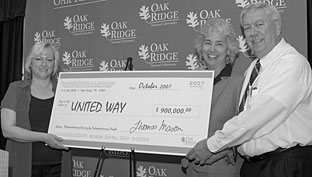 |
|
ORNL United Way Campaign Chair Karen Downer (left) presents a ceremonial check to Anderson County United Way Campaign co-chairs Kay Brookshire and Oak Ridge Mayor Tom Beehan. |
ORNL topped its United Way campaign goal again this year with staff members’ contributions and an $89,000 UT-Battelle corporate donation adding up to more than $916,000.
This year’s campaign goal was $825,000. ORNL is one of the top DOE labs in giving to the United Way.
“The heart of the campaign remains the individual employees,” says ORNL campaign chair Karen Downer. “I would like to take this opportunity to thank all the extraordinary ORNL employees who gave for the first time and who continue to give. Just like all of our work at ORNL, it matters and it makes a lasting difference.”
The campaign’s popular International Festival raised $4,450 and Club ORNL contributed over $5000 from the sale of coupon books.
In all, more than 2,300 ORNL employees contributed to the campaign. The number of leadership givers—monthly salaried employees who donate at least $1000 or 1.5 percent of their annual salaries, and bargaining-unit and weekly salaried employees who contribute $250 or more—increased by some 24 percent this year, to a total of 401.
Special activities included a campaign kick-off led by UT men’s basketball coach Bruce Pearl, a free-throw shooting contest and a breakfast for Leadership Givers featuring remarks by UT women’s athletic director Joan Cronan, which added several thousand dollars to the campaign.
ORNL donations include the following approximate amounts to counties in the region: Anderson, $271,000; Blount, $22,100; Campbell, $10,900; Knox, $377,000; Loudon, $49,500; McMinn, $2,500; Monroe, $5,900; Morgan, $31,400; Rhea, $2,600; Roane, $128,000; Sevier, $4,800; and
Union, $7,000.
This year’s campaign co-chair, Facilities & Operations Deputy Director Jimmy Stone, is set to lead next year’s campaign. Karen, who directs Environment, Safety, Health & Quality, is moving to Idaho National Laboratory for a similar post. —Cindy Lundy ![]()
